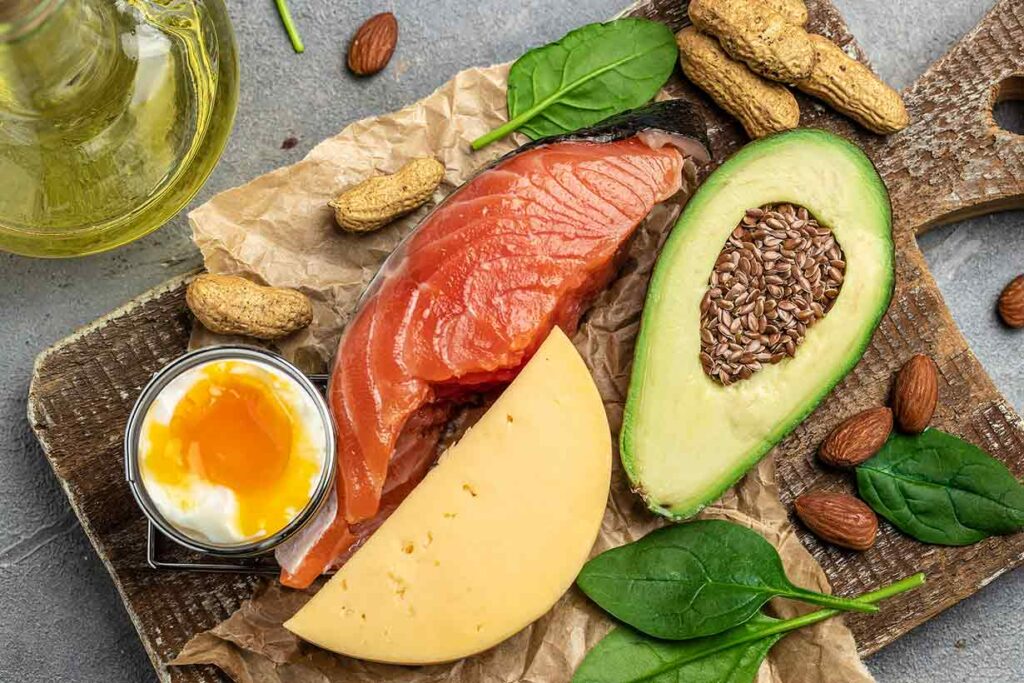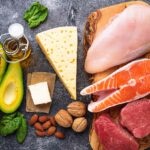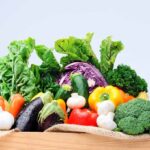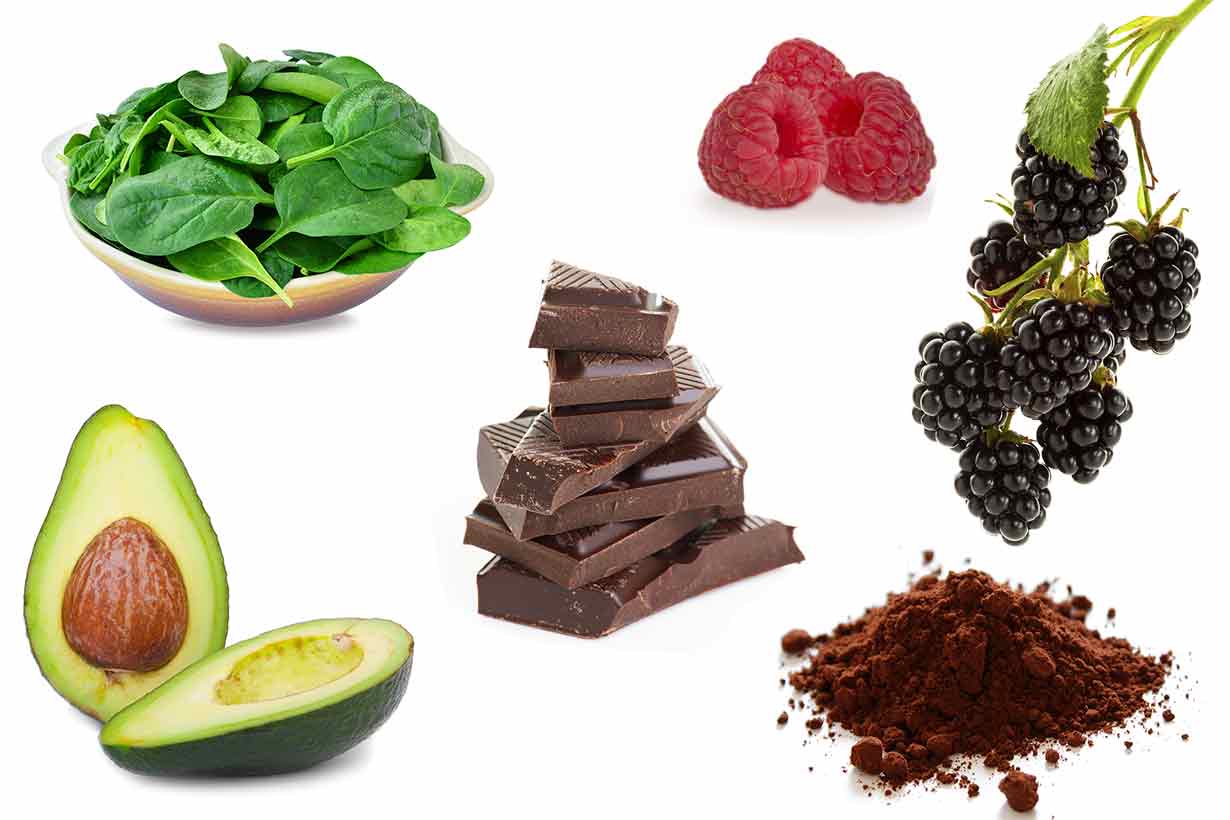Low-carb diets have been a popular way of eating over recent years.
However, whether or not these diets are health-promoting depends on the formulation of the diet.
Some versions of a low-carb diet may offer an excellent range of essential vitamins and minerals.
In contrast, others may fail at providing a nutritionally adequate intake.
This article provides information to enable a sufficient intake of every vitamin and mineral on a low-carb diet.
Table of contents

What Determines Whether a Food Is ‘Low-Carb-Friendly?’
First of all, a low-carb diet is defined by the overall carbohydrate intake throughout the day – not the carbohydrate content of specific foods.
For example, imagine someone following a low-carb diet has a carbohydrate intake target of <100 grams per day. Any food, even wheat bread, could fit into this diet if consumed in appropriate amounts to fit within the 100-gram limit.
However, foods like grains are very rich in carbohydrates, so consuming them makes it difficult to stick to a ‘low-carb’ diet.
Fruit is another category where some options are lower-carb than others.
For this reason, even if it isn’t an exact science, this guide will only class foods as ‘low-carb friendly’ if they contain fewer than 15 grams of carbohydrates per 100g weight.
Good Low-Carb-Friendly Sources of Every Vitamin and Mineral
A list of ten low-carb-friendly dietary sources will be provided for each vitamin and mineral.
Alongside this, the contribution of each food to the vitamin or mineral’s recommended daily value will be shown.
The source of all nutritional data is the USDA’s FoodData Central nutrition database.
Daily values (% DV) have been calculated using this USDA data and the FDA’s published daily values.
Calcium
The daily value for calcium is 1300 mg (1).
Here are ten low-carb friendly sources of calcium:
- Firm tofu, prepared with calcium sulfate: 683 mg calcium per 3.5 oz (100g), 53% DV (source)
- Sardines: 351 mg calcium per 92-gram can, 27% DV (source)
- Collard greens: 324 mg calcium per 130-gram cup (cooked), 25% DV (source)
- Whole milk: 300 mg calcium per 244-gram cup, 23% DV (source)
- Soy milk, fortified: 300 mg calcium per 244-gram cup, 23% DV (source)
- Plain yogurt: 296 mg calcium per 245-gram cup, 23% DV (source)
- Parmesan cheese: 251 mg calcium per ounce (oz)/28.35g, 19% DV (source)
- Whey protein isolate: 200 mg calcium per 29-gram scoop, 15% DV (source)
- Spinach: 209 mg calcium per 180-gram cup (cooked), 16% DV (source)
- Poppy seeds: 127 mg calcium per 8.8-gram tablespoon, 10% DV (source)
Copper
The daily value for copper is 0.9 mg (1).
Some of the best low-carb friendly copper sources include:
- Beef liver, cooked: 12.1 mg copper per 3 oz (85g), 1344% DV (source)
- Oysters, steamed: 4.84 mg copper per 3.5 oz (100g), 538% DV (source)
- Whey protein isolate: 2.5 mg copper per 29-gram scoop, 278% DV (source)
- Lobster, cooked, shell removed: 1.82 mg copper per small (118g) lobster, 202% DV (source)
- Whelk: 1.75 mg copper per 3 oz (85g), 194% DV (source)
- Soy protein isolate: 1.6 mg copper per 28.35-gram scoop, 178% DV (source)
- Blue crab: 1.02 mg copper per drained 125-gram can, 113% DV (source)
- Shiitake mushrooms: 0.76 mg copper per 3.5 oz (100g), 84% DV (source)
- White button mushrooms: 0.389 mg copper per 3.5 oz (100g), 43% DV (source)
- Firm tofu: 0.378 mg copper per 3.5 oz (100g), 42% DV (source)
Iodine
Iodine has a daily value of 150 mcg (1).
The USDA database does not have entries as standard for iodine, and this is because the iodine content in food can significantly vary from place to place.
For example, the content of iodine in the sea and soil can determine the amount of the mineral in seafood and vegetables.
However, while the following amounts sourced from the National Institutes of Health are estimates, the following foods should all be a good source of iodine:
- Seaweed, nori, dried: 116 mcg iodine per 2 tablespoons (5g), 77% DV (source)
- Cod, cooked: 99 mcg iodine per 3 oz (85g), 66% DV (source)
- Whole milk: 94 mcg iodine per 249-gram cup, 63% DV (source)
- Oysters, cooked: 93 mcg iodine per 3 oz (85g), 62% DV (source)
- Greek yogurt, plain, non-fat: 87 mcg iodine per 3/4 cup, 58% DV (source)
- Iodized table salt: 76 mcg iodine per 1/4 teaspoon, 51% DV (source)
- Eggs, hard-boiled: 26 mcg iodine per large egg, 17% DV (source)
- Cheddar cheese: 15 mcg iodine per oz (28.35g), 10% DV (source)
- Beef liver, cooked: 14 mcg iodine per 3 oz (85g), 9% DV (source)
- Shrimp, cooked: 13 mcg per 3 oz (85g), 9% DV (source)
Iron
The current daily value for iron is 18 mg (1).
Here are ten sources of iron that fit well with a low-carb diet:
- Cuttlefish, cooked: 9.18 mg iron per 3 oz (85g), 51% DV (source)
- Whelk, cooked: 8.58 mg iron per 3 oz (85g), 48% DV (source)
- Oysters: 8.26 mg iron per 3.5 oz (100g), 46% DV (source)
- Octopus, cooked: 8.11 mg iron per 3 oz (85g), 45% DV (source)
- Morel mushrooms, raw: 8.05 mg iron per 66-gram cup, 45% DV (source)
- Mussels, cooked: 6.72 mg iron per 3.5 oz (100g), 37% DV (source)
- Beef liver, cooked: 5.52 mg iron per 3 oz (85g), 31% DV (source)
- Edamame, cooked: 3.52 mg iron per 160-gram cup, 20% DV (source)
- Firm tofu: 2.66 mg iron per 3.5 oz (100g), 15% DV (source)
- Ground beef, 90% lean, cooked: 2.46 mg iron per 3 oz (85g), 14% DV (source)
Magnesium
Magnesium has a daily value of 420 mg (1).
Seafood tends to be the best low-carb source of magnesium; here are some of the best sources:
- Conch, cooked: 302 mg magnesium per 127-gram cup, 72% DV (source)
- Spinach, cooked: 157 mg magnesium per 180-gram cup, 37% DV (source)
- Swiss chard, cooked: 150 mg magnesium per 175-gram cup, 36% DV (source)
- Whelk, cooked: 146 mg magnesium per 3 oz (85g), 35% DV (source)
- Edamame, cooked: 99.2 mg magnesium per 160-gram cup, 24% DV (source)
- Atlantic mackerel, cooked: 85.4 mg magnesium per 88-gram fillet, 20% DV (source)
- Whey protein isolate: 67 mg magnesium per 29-gram scoop, 16% DV (source)
- Firm tofu: 58 mg magnesium per 3.5 oz (100g), 14% DV (source)
- Oysters: 36 mg magnesium per 3.5 oz (100g), 9% DV (source)
- Pumpkin seeds: 156 mg magnesium per ounce (28.35g), 5% DV (source)
Manganese
Manganese has a daily value of 2.3 mg (1).
Here are some manganese-rich, low-carb foods:
- Mussels, cooked: 6.8 mg manganese per 3.5 oz (100g), 296% DV (source)
- Pine nuts: 2.5 mg manganese per oz (28.35g), 109% DV (source)
- Hemp seeds: 2.15 mg manganese per oz (28.35g), 93% DV (source)
- Hazelnuts: 1.75 mg manganese per oz (28.35g), 76% DV (source)
- Spinach, cooked: 1.68 mg manganese per 180-gram cup, 73% DV (source)
- Edamame, cooked from frozen: 1.58 mg manganese per 155-gram cup, 69% DV (source)
- Coconut meat: 1.2 mg manganese per 80-gram cup, 52% DV (source)
- Firm tofu: 1.18 mg manganese per 3.5 oz (100g), 51% DV (source)
- Blueberries: 0.423 mg manganese per 3.5 oz (100g), 18% DV (source)
- Coconut milk: 0.12 mg manganese per 15-gram tablespoon, 5% DV (source)
Phosphorus
The daily value for phosphorus is 1250 mg (1).
Here are some of the best low-carb sources of phosphorus:
- Cuttlefish, cooked: 493 mg phosphorus per 3 oz (85g), 39% DV (source)
- Sardines: 451 mg phosphorus per 92-gram can, 36% DV (source)
- Salmon, cooked: 372 mg phosphorus per 4 oz (113g), 30% DV (source)
- Pork chop, cooked: 362 mg phosphorus per large (8 oz) pork chop, 29% DV (source)
- Chicken leg, cooked: 282 mg phosphorus per 155-gram leg, 23% DV (source)
- Skim milk: 263 mg phosphorus per 246-gram cup, 21% DV (source)
- Ground turkey, 93% lean, cooked: 178 mg phosphorus per 3 oz (85g), 14% DV (source)
- Parmesan cheese: 180 mg phosphorus per oz (28.35g), 14% DV (source)
- Whey protein isolate: 167 mg phosphorus per 29-gram scoop, 13% DV (source)
- Tuna: 137 mg phosphorus per 142-gram can, 11% DV (source)
Potassium
Potassium has a daily value of 4700 mg (1).
Here are some of the best low-carb sources of potassium:
- Beet greens, cooked: 1310 mg potassium per 144-gram cup, 28% DV (source)
- Swiss chard, cooked: 961 mg potassium per 175-gram cup, 20% DV (source)
- Spinach, cooked: 839 mg potassium per 180-gram cup, 18% DV (source)
- Avocado: 728 mg potassium per 150-gram avocado fruit, 15% DV (source)
- Edamame, cooked: 675 mg potassium per 160-gram cup, 14% DV (source)
- Pork chop, broiled: 601 mg potassium per large (8 oz) pork chop, 13% DV (source)
- Salmon, cooked: 522 mg potassium per 4 oz (113g), 11% DV (source)
- Herring, cooked: 467 mg potassium per 4 oz (113g), 10% DV (source)
- Canned tuna: 250 mg potassium per 142-gram can, 5% DV (source)
- Whey protein isolate: 250 mg potassium per 29-gram scoop, 5% DV (source)
Selenium
The daily value for selenium is 55 mcg (1).
Some of the best selenium sources for a low-carb diet include:
- Brazil nuts: 538 mcg selenium per ounce (28.35g), 978% DV (source)
- Yellowfin tuna, cooked: 91.8 mcg selenium per 3 oz (85g), 167% DV (source)
- Mussels, cooked: 89.2 mcg selenium per 3.5 oz (100g), 162% DV (source)
- Pork chop, cooked: 62.5 mcg selenium per large (8 oz) pork chop, 114% DV (source)
- Tilapia, cooked: 59.4 mcg selenium per 113-gram fillet, 108% DV (source)
- Sardines: 48.5 mcg selenium per 92-gram can, 88% DV (source)
- Atlantic mackerel, cooked: 45.4 mcg selenium per 88-gram fillet, 83% DV (source)
- Salmon, cooked: 44.6 mcg selenium per 4 oz (113g), 81% DV (source)
- Oysters, cooked: 39.2 mcg selenium per 3.5 oz (100g), 71% DV (source)
- Beef liver, cooked: 30.4 mcg selenium per 3 oz (85g), 55% DV (source)
Sodium
The daily value for sodium is 2300 mg (1).
Some low-carb friendly sources of sodium include:
- Table salt: 2360 mg sodium per 6.1-gram teaspoon, 103% DV (source)
- Salami: 986 mg sodium per 2oz (56-gram), 43% DV (source)
- Pepperoni: 885 mg sodium per 4 oz (113g), 38% DV (source)
- Smoked haddock: 862 mg sodium per 4oz (113g), 37% DV (source)
- Blue crab: 704 mg sodium per drained 125-gram can, 31% DV (source)
- Sauerkraut: 661 mg sodium per 3.5 oz (100g), 29% DV (source)
- Cured ham: 567 mg sodium per 42-gram medium slice, 25% DV (source)
- Bacon, cooked: 531 mg sodium per 3 slices (24.3g), 23% DV (source)
- Kimchi: 498 mg sodium per 3.5 oz (100g), 22% DV (source)
- Pickles, cucumber: 326 mg sodium per 404-gram spear, 14% DV (source)
Zinc
Zinc has a daily value of 11 mg (1).
Here are some good low-carb zinc sources:
- Oysters, steamed: 78.3 mg per 3.5 oz (100g), 712% DV (source)
- Ground beef, 90% lean, cooked: 5.65 mg zinc per 3.5 oz (100g), 51% DV (source)
- Lobster, cooked, shell removed: 4.74 mg zinc per small (118g) lobster, 43% DV (source)
- Blue crab: 4.76 mg zinc per drained 125-gram can, 43% DV (source)
- Beef liver, cooked: 4.47 mg zinc per 3oz (85g), 41% DV (source)
- Ground lamb, cooked: 3.94 mg per 3 oz (85g), 36% DV (source)
- Chicken leg, cooked: 2.76 mg zinc per medium (140g) leg, 25% DV (source)
- Pork chop, baked: 2.52 mg zinc per large (8 oz) pork chop, 23% DV (source)
- Firm tofu: 1.57 mg per 3.5 oz (100g), 14% DV (source)
- Cured ham: 0.932 mg zinc per 42-gram medium slice, 8% DV (source)
Vitamin A, Retinol Activity Equivalents (RAE)
Vitamin A has a daily value of 900 mcg RAE (1).
Here are some excellent low-carb sources of vitamin A:
- Beef liver, cooked: 7960 mcg vitamin A RAE per 3 oz (85g) (source)
- Chicken liver, cooked: 3360 mcg vitamin A RAE per 3 oz (85g) (source)
- Butternut squash, cooked: 1140 mcg vitamin A RAE per 205-gram cup (source)
- Carrots, cooked: 1300 mcg vitamin A RAE per 160-gram cup (source)
- Liverwurst: 2360 mcg vitamin A RAE per 2 oz (56g) (source)
- Eel, cooked: 897 mcg vitamin A RAE per 4 oz (113g) (source)
- Pumpkin, cooked: 996 mcg vitamin A RAE per 230-gram cup (source)
- Bluefin tuna, cooked: 643 mcg vitamin A RAE per 3 oz (85g) (source)
- Spinach, cooked: 941 mcg vitamin A RAE per 180-gram cup (source)
- Kale, cooked: 318 mcg vitamin A RAE per 130-gram cup (source)
Vitamin C
The daily value for vitamin C is 90 mg (1).
Some low-carb friendly foods that are rich in vitamin C include:
- Yellow bell pepper, raw: 342 mg vitamin C per large (186g) pepper, 380% DV (source)
- Red bell pepper, raw: 210 mg vitamin C per large (164g) pepper, 233% DV (source)
- Green chili pepper: 182 mg vitamin C per 75-gram 0.5 cup, 202% DV (source)
- Blackcurrants: 181 mg vitamin C per 3.5 oz (100g), 201% DV (source)
- Green bell pepper, raw: 132 mg vitamin C per large (164g) pepper, 147% DV (source)
- Broccoli, cooked: 122 mg vitamin C per 155-gram cup, 136% DV (source)
- Kiwi fruit: 56 mg vitamin C per 75g kiwi fruit, 62% DV (source)
- Beef spleen, cooked: 42.8 mg vitamin C per 3 oz (85g), 48% DV (source)
- Lemon: 34.4 mg vitamin C per 65g fruit, 38% DV (source)
- Lime: 18.9 mg vitamin C per 65g fruit, 21% DV (source)
Vitamin D
Vitamin D has a daily value of 20 mcg (1).
Here are some low-carb vitamin D sources:
- Swordfish, cooked: 39.8 mcg vitamin D per 170-gram fillet, 199% DV (source)
- Eel, cooked: 33.1 mcg vitamin D per 4 oz (113g), 166% DV (source)
- Cremini mushrooms, exposed to UV light: 27.8 mcg vitamin D per 87-gram cup, 139% DV (source)
- Maitake mushrooms, exposed to UV light: 19.7 mcg vitamin D per 70-gram cup, 99% DV (source)
- Atlantic mackerel, raw weight: 18 mcg vitamin D per 112-gram fillet, 90% DV (source)
- Rainbow trout, cooked: 16.2 mcg vitamin D per 3 oz (85g), 81% DV (source)
- Salmon, cooked: 15.5 mcg vitamin D per 4 oz (113g), 78% DV (source)
- Cod liver oil: 11.2 mcg vitamin D per 4.5-gram teaspoon, 56% DV (source)
- Halibut, cooked: 6.44 mcg vitamin D per 4 oz (113g), 32% DV (source)
- Herring, cooked: 5.76 mcg vitamin D per 4 oz (113g), 29% DV (source)
Vitamin E
The daily value for vitamin E is 15 mg (1).
Here are some of the best low-carb friendly vitamin E sources:
- Wheat germ oil: 20.9 mg vitamin E per 14-gram tablespoon, 139% DV (source)
- Conch, cooked: 8.04 mg vitamin E per 127-gram cup, 54% DV (source)
- Sunflower seeds: 7.4 mg vitamin E per oz (28.35g), 49% DV (source)
- Almond milk, unsweetened: 6.86 mg vitamin E per 244-gram cup, 46% DV (source)
- Almonds: 6.78 mg vitamin E per oz (28.35g), 45% DV (source)
- Eel, cooked: 5.68 mg vitamin E per 4 oz (113g), 38% DV (source)
- Avocado: 3.1 mg vitamin E per 150-gram avocado, 21% DV (source)
- Rainbow trout, cooked: 2.37 mg vitamin E per 3 oz (85g), 16% DV (source)
- Whey protein isolate: 2.25 mg vitamin E per 29g scoop, 15% DV (source)
- Olive oil: 2.02 mg vitamin E per 14-gram tablespoon, 13% DV (source)
Vitamin K
Vitamin K has a daily value of 120 mcg (1)
Some low-carb foods rich in vitamin K include:
- Spinach, cooked: 1020 mcg vitamin K per 180-gram cup, 850% DV (source)
- Dandelion greens, cooked: 894 mcg vitamin K per 110-gram cup, 745% DV (source)
- Beet greens, cooked: 628 mcg vitamin K per 150-gram cup, 523% DV (source)
- Kale, cooked: 543 mcg vitamin K per 130-gram cup, 453% DV (source)
- Brussels sprouts, cooked: 285 mcg vitamin K per 155-gram cup, 238% DV (source)
- Spring/green onions, cooked: 238 mcg vitamin K per 225-gram cup, 198% DV (source)
- Broccoli, cooked: 164 mcg vitamin K per 155-gram cup, 137% DV (source)
- Cabbage, green, cooked: 118 mcg vitamin K per 150-gram cup, 98% DV (source)
- Watercress, raw: 85 mcg vitamin K per 34-gram cup, 71% DV (source)
- Parsley, fresh: 62.3 mcg vitamin K per 3.8-gram tablespoon, 52% DV (source)
Thiamin (Vitamin B1)
Thiamin has a daily value of 1.2 mg (1).
Some good dietary sources of thiamin that are low in carbohydrates include:
- Pork chop, cooked: 0.74 mg thiamin per large (8oz) pork chop, 62% DV (source)
- Ground pork, cooked: 0.595 mg thiamin per 3 oz (85g), 50% DV (source)
- Kidney bean sprouts, cooked: 0.362 mg thiamin per 3.5 oz (100g), 30% DV (source)
- Edamame, cooked: 0.294 mg thiamin per 160-gram cup, 25% DV (source)
- Cured ham: 0.258 mg thiamin per 42-gram slice, 22% DV (source)
- Whey protein isolate: 0.25 mg per 29g scoop, 21% DV (source)
- Lamb liver, cooked: 0.196 mg thiamin per 3 oz (85g), 16% DV (source)
- Pistachio nuts, without shell: 0.191 mg thiamin per oz (28.35g), 16% DV (source)
- Peanuts: 0.181 mg thiamin per oz (28.35g), 15% DV (source)
- Eggplant, cooked: 0.036mg thiamin per 95-gram cup, 3% DV (source)
Riboflavin (Vitamin B2)
Riboflavin has a daily value of 1.3 mg (1).
Here are some low-carb riboflavin sources:
- Lamb liver, cooked: 3.42 mg riboflavin per 3 oz (85g), 263% DV (source)
- Beef liver, cooked: 2.89 mg riboflavin per 3 oz (85g), 222% DV (source)
- Monster Energy, ‘Lo-carb’: 1.7 mg riboflavin per 8oz (240ml) serving, 131% DV (source)
- Cuttlefish, cooked: 1.47 mg riboflavin per 3 oz (85g), 113% DV (source)
- Squid, cooked: 0.663 mg riboflavin per 3 oz (85g), 51% DV (source)
- Soy milk: 0.449 mg riboflavin per 244-gram cup, 35% DV (source)
- Atlantic mackerel, cooked: 0.363 mg riboflavin per 88-gram fillet, 28% DV (source)
- Goat cheese, hard: 0.337 mg riboflavin per oz (28.35g), 26% DV (source)
- Skim milk: 0.32 mg riboflavin per 244-gram cup, 25% DV (source)
- Skirt steak, cooked: 0.162 mg riboflavin per 3 oz (85g), 12% DV (source)
Niacin (Vitamin B3)
The daily value for niacin is 16 mg niacin equivalents (mg NE) (1).
Some of the best low-carb sources of niacin include:
- Rockstar Energy, sugar-free: 20 mg NE per 8 fl oz (240ml) can, 125% DV (source)
- Yellowfin tuna, cooked: 18.8 mg NE per 3 oz (85g), 118% DV (source)
- Chicken breast, with skin, cooked: 12.1 mg NE per 130-gram breast, 76% DV (source)
- Salmon, cooked: 10.8 mg NE per 4 oz (113g), 68% DV (source)
- Portobello mushrooms, cooked: 7.58 mg NE per 121-gram cup, 47% DV (source)
- Atlantic mackerel, cooked: 6.03 mg NE per 88-gram fillet, 38% DV (source)
- Roast duck, with skin: 5.76 mg NE per 120-gram breast, 36% DV (source)
- Ground turkey, 93% lean, cooked: 5.64 mg NE per 3 oz (85g), 35% DV (source)
- Spanish peanuts: 4.51 mg NE per oz (28.35g), 28% DV (source)
- Sunflower seeds: 2.0 mg NE per oz (28.35g), 13% DV (source)
Pantothenic Acid (Vitamin B5)
Pantothenic acid has a daily value of 5 mg (1).
Some low-carb sources of pantothenic acid include:
- Beef liver, cooked: 6.04 mg pantothenic acid per 3 oz (85g), 121% DV (source)
- Shiitake mushrooms, cooked: 5.2 mg pantothenic acid per 145-gram cup, 104% DV (source)
- Abalone, cooked: 2.44 mg pantothenic acid per 3 oz (85g), 49% DV (source)
- Sunflower seeds: 2.0 mg pantothenic acid per 3 oz (85g), 40% DV (source)
- Chicken leg, with skin, cooked: 1.58 mg pantothenic acid per 133-gram thigh, 32% DV (source)
- Bluefin tuna, cooked: 1.16 mg pantothenic acid per 3 oz (85g), 23% DV (source)
- Ground turkey, 93% lean, cooked: 1.1 mg pantothenic acid per 3 oz (85g), 22% DV (source)
- Whole milk: 0.901 mg pantothenic acid per 249-gram cup, 18% DV (source)
- Eggs, hard-boiled: 0.7 mg pantothenic acid per 50-gram egg, 14% DV (source)
- Pink salmon, canned: 0.468 mg pantothenic acid per 3 oz (85g), 9% DV (source)
Vitamin B6
The daily value for vitamin B6 is 1.7 mg (1).
Some of the best vitamin B6 dietary sources that are low-carb include:
- Yellowfin tuna, cooked: 0.884 mg vitamin B6 per 3 oz (85g), 52% DV (source)
- Salmon, cooked: 0.783 mg vitamin B6 per 4 oz (113g), 46% DV (source)
- Pork loin steak, lean, cooked: 0.606 mg vitamin B6 per 3 oz (85g), 36% DV (source)
- Ancho Pepper, dried: 0.602 mg vitamin B6 per 17-gram dried pepper, 35% DV (source)
- Whelk, cooked: 0.552 mg vitamin B6 per 3 oz (85g), 32% DV (source)
- Ground turkey, 93% lean, cooked: 0.4 mg vitamin B6 per 3 oz (85g), 24% DV (source)
- Chicken breast, with skin, cooked: 0.399 mg vitamin B6 per 130-gram breast, 23% DV (source)
- Avocado: 0.386 mg vitamin B6 per 150-gram fruit, 23% DV (source)
- Pistachio nuts: 0.309 mg vitamin B6 per oz (28.35g), 18% DV (source)
- Beef chuck steak, cooked: 0.264 mg vitamin B6 per 3 oz (85g), 16% DV (source)
Folate (B9)
Folate has a daily value of 400 mcg of dietary folate equivalents (DFE) (1).
Here are some folate-rich foods that are low-carb:
- Chicken liver, cooked: 491 mcg DFE per 3 oz (85g), 123% DV (source)
- Edamame, cooked: 458 mcg DFE per 160-gram cup, 115% DV (source)
- Spinach, cooked: 307 mcg DFE per 185-gram cup, 77% DV (source)
- Conch, cooked: 227 mcg DFE per 127-gram cup, 57% DV (source)
- Beef liver, cooked: 213 mg DFE per 3 oz (85g), 53% DV (source)
- Artichoke, cooked: 151 mcg DFE per 170-gram cup, 38% DV (source)
- Broccoli, cooked: 86.8 mcg DFE per 155-gram cup, 22% DV (source)
- Asparagus, cooked: 84.6 mcg DFE per 3 oz (85g), 21% DV (source)
- Sunflower seeds: 67.2 mcg DFE per oz (28.35g), 17% DV (source)
- Blue crab: 63.8 mcg DFE per 125-gram drained can, 16% DV (source)
Vitamin B12
The vitamin B12 daily value is set at 2.4 mcg (1).
The following foods are all rich in vitamin B12 and low-carb friendly:
- Beef liver, cooked: 59.5 mcg vitamin B12 per 3 oz (85g), 2479% DV (source)
- Mussels, cooked: 32.2 mcg vitamin B12 per 150-gram cup, 1342% DV (source)
- Clams, cooked: 30.3 mcg vitamin B12 per 150-gram cup, 1263% DV (source)
- Atlantic mackerel: 16.7 mcg vitamin B12 per 88-gram fillet, 696% DV (source)
- Herring, cooked: 16.5 mcg vitamin B12 per 4 oz (113g), 688% DV (source)
- Oysters, cooked: 15.7 mcg vitamin B12 per 3.5 oz (100g), 654% DV (source)
- Whelk, cooked: 15.4 mcg vitamin B12 per 3 oz (85g), 642% DV (source)
- Chicken liver, cooked: 14.2 mcg vitamin B12 per 3 oz (85g), 592% DV (source)
- Ground beef, 90% lean, cooked: 2.12 mcg vitamin B12 per 3 oz (85g), 88% DV (source)
- Soy milk, fortified: 2.07 mcg vitamin B12 per 244-gram cup, 86% DV (source)
Summary
Popular communication regarding low-carb dietary patterns doesn’t always provide appropriate information to make the diet nutritionally adequate.
Including some of the foods featured in this guide may enable an improved intake of essential vitamins and minerals for individuals following a low-carb diet.




